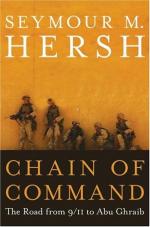
|
| Name: _________________________ | Period: ___________________ |
This test consists of 15 multiple choice questions and 5 short answer questions.
Multiple Choice Questions
1. What did CENTCOM think it would be unrealistic to invade Iraq without?
(a) A large ground force.
(b) Really good maps.
(c) Lots of air support.
(d) Lots of naval support.
2. What was the code name for the U.S. Army offensive in western Afghanistan?
(a) Operation Gorilla.
(b) Operation Mule.
(c) Operation Sky-drop.
(d) Operation Anaconda.
3. What did members of the mission to get Taliban leader Mullah Omar complain of?
(a) Lack of men.
(b) Lack of planning.
(c) Lack of maps.
(d) Lack of resources.
4. According to comments, who had lowered the bar and provided an excuse to ignore the Geneva Conventions in the future?
(a) Rice.
(b) Rumsfeld.
(c) Cheney.
(d) Bush.
5. When did the Soviet Union collapse?
(a) Mid 80's.
(b) 1982.
(c) Late 80's.
(d) Early 80's.
6. What term did the Pentagon use to describe the abuses in Iraq and Afghanistan?
(a) Battle pressures syndrome.
(b) Rotten apple syndrome.
(c) Herding cats syndrome.
(d) Goose egg syndrome.
7. Perle had worked closely with Douglas Frith since when?
(a) 1990.
(b) 1987.
(c) 1989.
(d) 1988.
8. What was the chain of command like in the Iraqi prisons?
(a) Confusing.
(b) Clear.
(c) Delineated.
(d) Blurred.
9. Who killed Abdul Haq, an Afghan leader supposedly working for the CIA?
(a) Mullah Omar.
(b) The Taliban.
(c) U.S. Special Forces.
(d) Al Qaeda.
10. A Clinton Administration Director of Persian Gulf Affairs estimated that it would take how long for all the troops to be readied for an Iraqi invasion?
(a) 1 year.
(b) 3-5 months.
(c) 9-11 months.
(d) 4-6 months.
11. When did the Northern Alliance take Kabul?
(a) October 2001.
(b) November 2001.
(c) December 2001.
(d) September 2001.
12. Who was the leader of the Iraqi National Congress?
(a) Ahmad Kalan.
(b) Ahmad Jablai.
(c) Ahmad Chalabi.
(d) Ahmad Currin.
13. What magazine has Hersh written for since the early 1990s?
(a) Newsweek.
(b) The New York Times.
(c) The New Yorker.
(d) Time.
14. What was the President's Special Access Program used in Iraq against?
(a) The terrorists.
(b) The rebels.
(c) The insurgency.
(d) The hardliners.
15. When was the Presidential Daily Brief titled "Bin Laden Determined to Strike in U.S." given?
(a) August 2001.
(b) September 2001.
(c) July 2001.
(d) June 2001.
Short Answer Questions
1. What city is Abu Ghraib located on the outskirts of?
2. When did Ahmad present the Clinton Administration with an overthrow plan?
3. What happened to all possibly "dirty" agents in the C.I.A.?
4. After the U.S. Army operation in western Afghanistan, how many Al Qaeda members were supposedly killed?
5. Who began advocating a pre-emptive military action against Iraq in the Bush Administration?
|
This section contains 389 words (approx. 2 pages at 300 words per page) |

|




